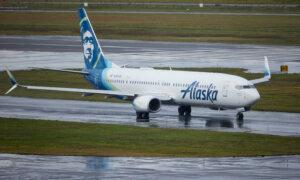The Federal Aviation Administration (FAA) asked Boeing to inspect a second of its plane models for potential safety hazards just weeks after it grounded the 737-9 Max model because of a midflight incident.
“As an added layer of safety, the Federal Aviation Administration (FAA) is recommending that operators of Boeing 737-900ER aircraft visually inspect mid-exit door plugs to ensure the door is properly secured,” the FAA said in a Jan. 21 statement.
The agency clarified that the Boeing 737-900ER “is not part of” the newer Boeing 737-9 Max that has already been grounded. However, both have the same door plug design.
Issues Discovered
Inspections conducted by Alaska Airlines and United Airlines found that some of the door plugs of the aircraft model had bolts that had not been tightened enough.The FAA required that a new “rigorous inspection and maintenance process” for the aircraft be created before the agency returns grounded planes back into service.
“The first 40 inspections that are part of that process are now complete, and the FAA will thoroughly review the data from them,” the agency said on Jan. 17.
“All 737-9 MAX aircraft with door plugs will remain grounded pending the FAA’s review and final approval of an inspection and maintenance process that satisfies all FAA safety requirements. Once the FAA approves an inspection and maintenance process, it will be required on every grounded 737-9 MAX prior to future operation.”
The FAA did not specify when the planes can be expected back in service. Instead, it said that the “safety of the flying public ... will determine the timeline for returning these aircraft to service.”
The firm describes itself as “the world’s largest tier-one manufacturer and supplier of aerostructures for premier commercial and defense aerospace programs.”
Boeing Oversight
The FAA is also increasing its oversight of the production and manufacturing processes at Boeing. On Jan. 12, it announced that it was conducting an audit involving the Boeing 737-9 Max production line and its suppliers to assess the company’s compliance with approved quality procedures.“The results of the FAA’s audit analysis will determine whether additional audits are necessary,” the agency stated. There will also be increased monitoring of the plane’s in-service events.
“It is time to re-examine the delegation of authority and assess any associated safety risks,” FAA Administrator Mike Whitaker said.
“The grounding of the 737-9 and the multiple production-related issues identified in recent years require us to look at every option to reduce risk. The FAA is exploring the use of an independent third party to oversee Boeing’s inspections and its quality system.”
Boeing said it welcomes the FAA announcement of increased oversight and will “cooperate fully and transparently with” the regulator.
On Jan. 17, Secretary of State Antony Blinken had to change planes when an unspecified mechanical failure was discovered on the modified Boeing 737 jet he had flown to Davos for the World Economic Forum. The issue was identified before the plane took off.
From the Jan. 5 Alaska Airlines incident to Jan. 22, shares of Boeing fell from $249 to $213, a decline of more than 14 percent.
Six passengers from the Alaska Airlines flight are suing Boeing, alleging that the mishap “physically injured some passengers and emotionally traumatized most if not all aboard.”
According to the lawsuit, one passenger suffered soft tissue injuries on her neck and back. She also lost hearing ability and her left ear bled internally. Another passenger experienced a seizure after he disembarked from the plane due to the “trauma of his experience” coupled with an underlying condition.







